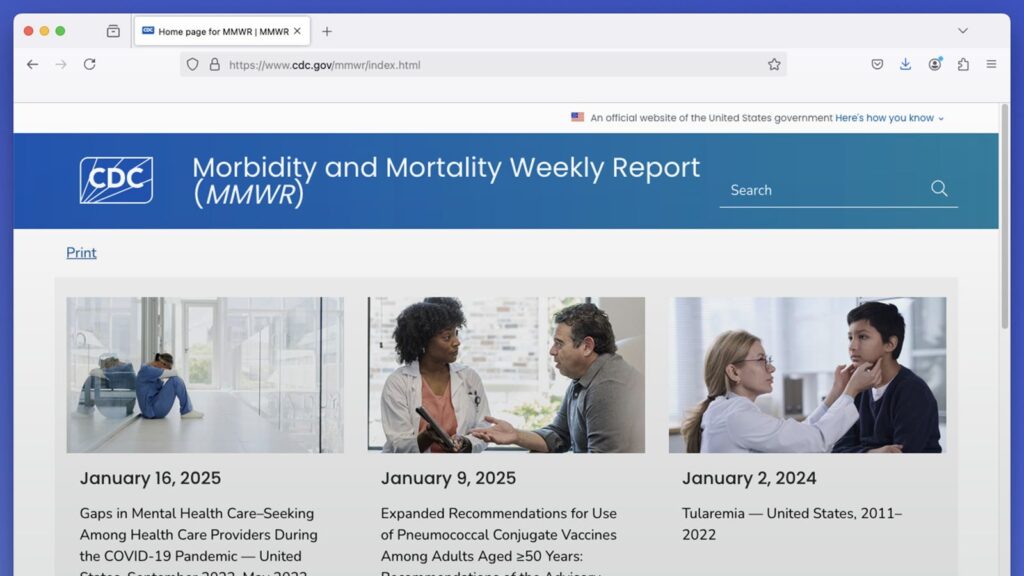[ad_1]
For the first time in its more than 60-year history, the CDC’s Morbidity and Mortality Weekly Report (MMWR) did not go out as scheduled because of a communications pause at federal health agencies issued by the Trump administration.
Past editors of MMWR and prior leaders of CDC lamented the lack of publication, and its potential impact on the distribution of vital public health information.
“This is a concerning precedent that public health messages won’t be left to public health professionals and experts, and instead will be potentially controlled by politicians,” Sonja Rasmussen, MD, a former editor of MMWR who worked at the CDC for 20 years, told MedPage Today.
“If they have information that they believe is important enough to get out in the MMWR … I, as a physician, want to be able to have that information to take the best care of my patients,” she added.
Tom Frieden, MD, MPH, who served as CDC director from 2009 to 2017 and is now president and CEO of Resolve to Save Lives, said MMWR has published “without a break every week since 1960” and its predecessor publications did so weekly since 1887.
“The bottom line is every day the publication is delayed, doctors, nurses, hospitals, local health departments, and first responders are behind the information curve and less prepared to protect the health of all Americans,” Frieden said in a statement shared with MedPage Today.
Richard Besser, MD, who served as acting CDC director for 6 months in 2009, urged the Trump administration to expeditiously lift the pause.
“Not a day goes by when CDC isn’t tracking a potential threat to our health,” Besser said in a statement to MedPage Today. “Cutting off communications from CDC puts our health at risk and prevents our doctors, nurses, and public health leaders in our communities from doing their jobs.”
The pause went into effect on Tuesday and is in effect through Feb. 1, according to the Associated Press, which obtained a memo from acting HHS Secretary Dorothy Fink, MD. It applies to public communications including press releases, social media posts, and websites, as well as anything intended to be published in the Federal Register, and, of course, MMWR.
MMWR has published without fail every week since its inception — though each year the Christmas week report is published in a double issue the following week, Rasmussen told MedPage Today. Even during government shutdowns the report has been put together by a skeleton crew, said another former CDC employee, who did not want to be named.
The first Trump administration also tried to gain control over MMWR, which had published information about the COVID pandemic that conflicted with messaging from the White House.
It’s unknown what information will be missed during this pause, though three reports about H5N1 were supposed to be published in this week’s edition, according to the Washington Post.
The former CDC employee who did not want to be named told MedPage Today they suspect the administration may not have realized the full implications of this gag order on the valuable resources, and that conversations are likely happening behind the scenes to try to convince the new administration to let MMWR go out. They pointed out that MMWR staff are still working and that if this pause continues through next week as currently planned, the articles would likely be put in the Feb. 6 issue.
Missing too many publications can result in getting delisted in Medline, which would mean the MMWR would no longer be an official publication of the National Library of Medicine. The institution did not respond to MedPage Today‘s inquiries on how many publications would have to be missed for this to happen.
Tina Tan, MD, president of the Infectious Diseases Society of America (IDSA), called the pause in publication of MMWR “a disaster.”
“These types of publications really are necessary to get out public health information to the public and to practitioners in a timely manner,” she told MedPage Today.
While IDSA is also tracking ongoing public health threats like H5N1 and rising respiratory virus cases, the communications pause is impacting them, too, Tan said. IDSA was supposed to have a joint clinician call with the CDC today to address the most prominent public health threats related to H5N1 — a meeting weeks in the making that had to be cancelled.
Becky Smullin Dawson, PhD, MPH, an epidemiologist at Allegheny College in Meadville, Pennsylvania, said that MMWR focuses the public health community’s attention and “helps to generate conversations, new research, public health programming, medical interventions, and health communications.”
“Taking away the MMWR from the public health community is equivalent to taking away a vital source of nutrition,” she said. “There will be a void when the electronic version of the MMWR is not in my inbox.”
As of press time, the CDC did not reply to a request for comment.
Please enable JavaScript to view the comments powered by Disqus.
[ad_2]
Source link : https://www.medpagetoday.com/infectiousdisease/generalinfectiousdisease/113905
Author :
Publish date : 2025-01-23 18:51:17
Copyright for syndicated content belongs to the linked Source.
